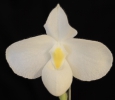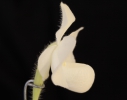|
|
|
|
|
| |
Flasks of
Paphiopedilum delenatii var. album 'MC7087' × self |
|
| |
|
|
| |
|
|
Click to Enlarge

Pod Parent Flower |
Click to Enlarge

Pod Parent Flower, Side View |
Click to Enlarge

Pod Parent Blooming Plant |
|
|
|
| |
For additional origin/habitat information supplied courtesy of
Charles and Margaret Baker, see further below, near the bottom of this page.
|
Temperatures we attempt to use in the lab & greenhouse:
| For Species: |
|
Spring, Summer, Autumn: days average 79°F, nights 63°F; best fit is Intermediate 83-60°F
(Source:
Baker's Web OSC) |
| For Species: |
|
Winter: days average 70°F, nights 57°F; best fit is Cool 70-52°F
(Source:
Baker's Web OSC) |
|
About the name...
| Etymology of |
album |
|
From Latin "albus" white.
(Source:
Mayr & Schmucker 1998) |
| Etymology of |
delenatii |
|
Named for Delenat, French horticulturist in the 1st half of the 20th century.
(Source:
Mayr & Schmucker 1998) |
| Etymology of |
Paphiopedilum |
|
From Greek "Paphia" the name of Aphrodite of Cypress; "pedilon", sandal.
(Source:
Pridgeon 1992) |
| Pronunciation of |
album |
|
AL-bum
(Source:
Hawkes 1978) |
| Pronunciation of |
Paphiopedilum |
|
paf-ee-oh-PED-i-lum
(Source:
Pridgeon 1992) |
|
If you would like to direct someone to this web page, please copy and paste this URL into your email:
http://troymeyers.com/d?018119
| Flask Information |
| Availability: |
We have sold all of the flasks for this item. |
| You should: |
Consider getting individual plants or compots instead of a flask.
See if we have plants available in the greenhouse. |
| Yield Estimate: |
271 plants (based on flask surveys done 06/06/2016 through 03/23/2019)
|
| Plantlet Sizes: |
From many flasks 2 - 70 mm plants (based on flask surveys done 06/06/2016 through 03/09/2019)
From one most recently surveyed flask 20 - 50 mm (03/09/2019)
|
|
You might also want to:
|
View the seed assay for this item.
See if we have plants available in the greenhouse.
View items of the same species.
View items of the same genus.
|
| Ordering Information |
| You are not currently logged in. |
|
You must be a registered user and be logged in to reserve a flask or place a notification request. Please log in:
|
|
|
|
|
|
| |
The origin/habitat information below is supplied courtesy of Charles and Margaret Baker
The following information is based on the name of the plant provided by the donor, and assumes that the name is correct. If the plant has been misidentified, then the following information may not be correct.
This text is copyrighted by the Bakers and may not be reproduced without permission.
ORIGIN/HABITAT: Vietnam. Plants were originally found in an unspecified
location in Tonkin, a region covering most of what is now northern
Vietnam. Populations of this species have been recently discovered in the
mountains of southern Vietnam in the region from near Dalat to west of Nha
Trang. These plants grow mostly on the eastern and southeastern slopes at
3600-3950 ft. (1100-1200 m), but collections have been made as low as 2600
ft. (800 m) and as high as 4900 ft. (1500 m).
Visitors to the habitat report that the plants grow on eastern-facing
slopes under climatic conditions that are closer to those found along the
coast than those in the interior mountain region around Dalat. These
plants grow in acid soils that have developed from acidic granite
substrate and are normally found in rock hollows or on small shelves on
steep granite slopes with a southern exposure. They are sometimes found in
crevices of nearly vertical granite cliffs, however, where short moss and
accumulations of leaf litter are sometimes present.
More about this information and the Bakers...
|
|
|
| |
|
|
|